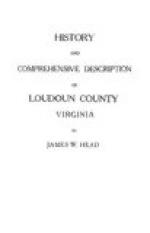When the British were on their way from Bladensburg to Washington, in August, 1814, James Monroe, then Secretary of State, had been for several days with General Winder, reconnoitering the enemy, and watching the movements of both armies. Knowing the weakness of the American forces, he believed Washington to be in great peril. He dispatched a letter to President Madison, advising the removal of the official records. Stephen Pleasanton, then a clerk in the State Department, made immediate preparation for the removal of the books and papers in that department. He had linen bags hastily made and placed in them the State archives, which were then loaded in wagons and hauled across the chain bridge, over the Potomac, to the grist mill of Edgar Patterson, two miles above Georgetown. Not feeling sure of their safety there, he had them reloaded on wagons and conveyed to Leesburg, where they were placed in an unoccupied building,[24] the key of which was given to a recently ordained clergyman, named Littlejohn. There they remained until the last hostile Briton had reached Baltimore, when they were carefully hauled back to Washington.[25] Thus we saved the precious documents of the revolutionary war, as well as our state archives, and thus does Leesburg boast, with abstract truthfulness, that for a little more than two weeks it was the Capital of the United States.
[Footnote 23: Anonymous.]
[Footnote 24: Perhaps the most precious of these documents was the Declaration of Independence, which it has been asserted, was deposited here.]
[Footnote 25: Mrs. A.H. Throckmorton, in an interesting narrative to which allusion is made elsewhere in this volume, differs with the authority here quoted as to the disposition of these important papers. She says: “For one night they remained in the court-house here (Leesburg) and were then carried several miles out in the country to the estate of “Rockeby,” now owned by Mr. H.B. Nalle,... and securely locked within the old vault and remained out of reach of the enemy for two weeks.”]
THE MASON-McCARTY DUEL.
The duel, February 6, 1819, between Armistead T. Mason and John M. McCarty, both residents of Loudoun County, was the second “affair of honor” to be settled on the now famous field of Bladensburg. They were cousins, who became enemies during Mason’s brief term in the United States Senate. Mason, known as “The Chief of Selma,” was a graduate of William and Mary College and the commander of a cavalry regiment[26] in the war of 1812. He later became brigadier general of the Virginia militia. He married and took up his residence at Selma plantation, four miles north of Leesburg. Wishing to make it possible for the Quakers of Loudoun to contribute their share toward the support of the army, Mason introduced in the Senate a bill to permit, in case of draft, the furnishing of substitutes on payment of $500 each. For this McCarty branded him a coward, and thence sprung a succession of bitter quarrels, the real basis of which was a difference of political opinions. The details of both sides of the feud were published weekly in the Leesburg “Genius of Liberty,” and later were issued in pamphlet form as campaign material.




